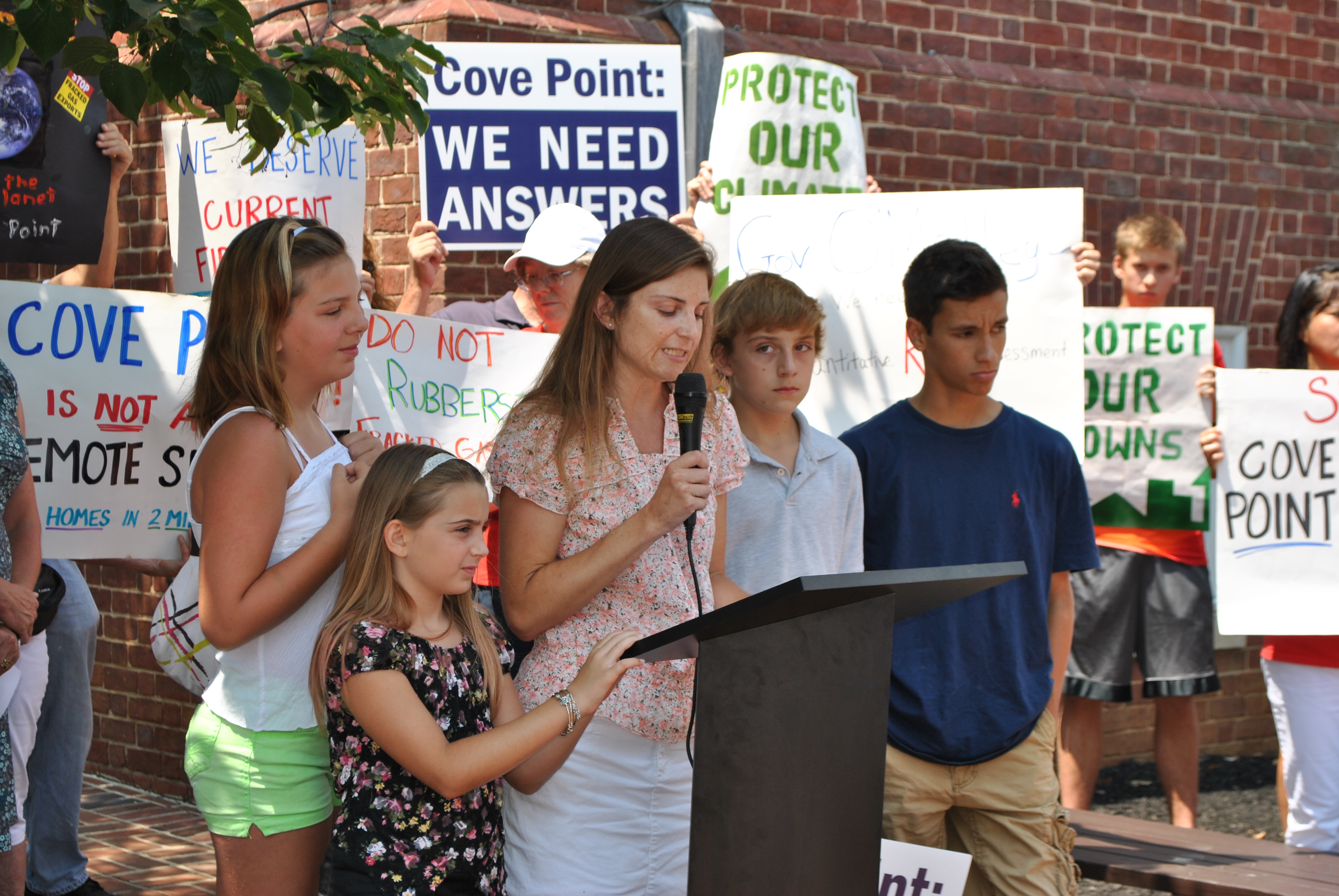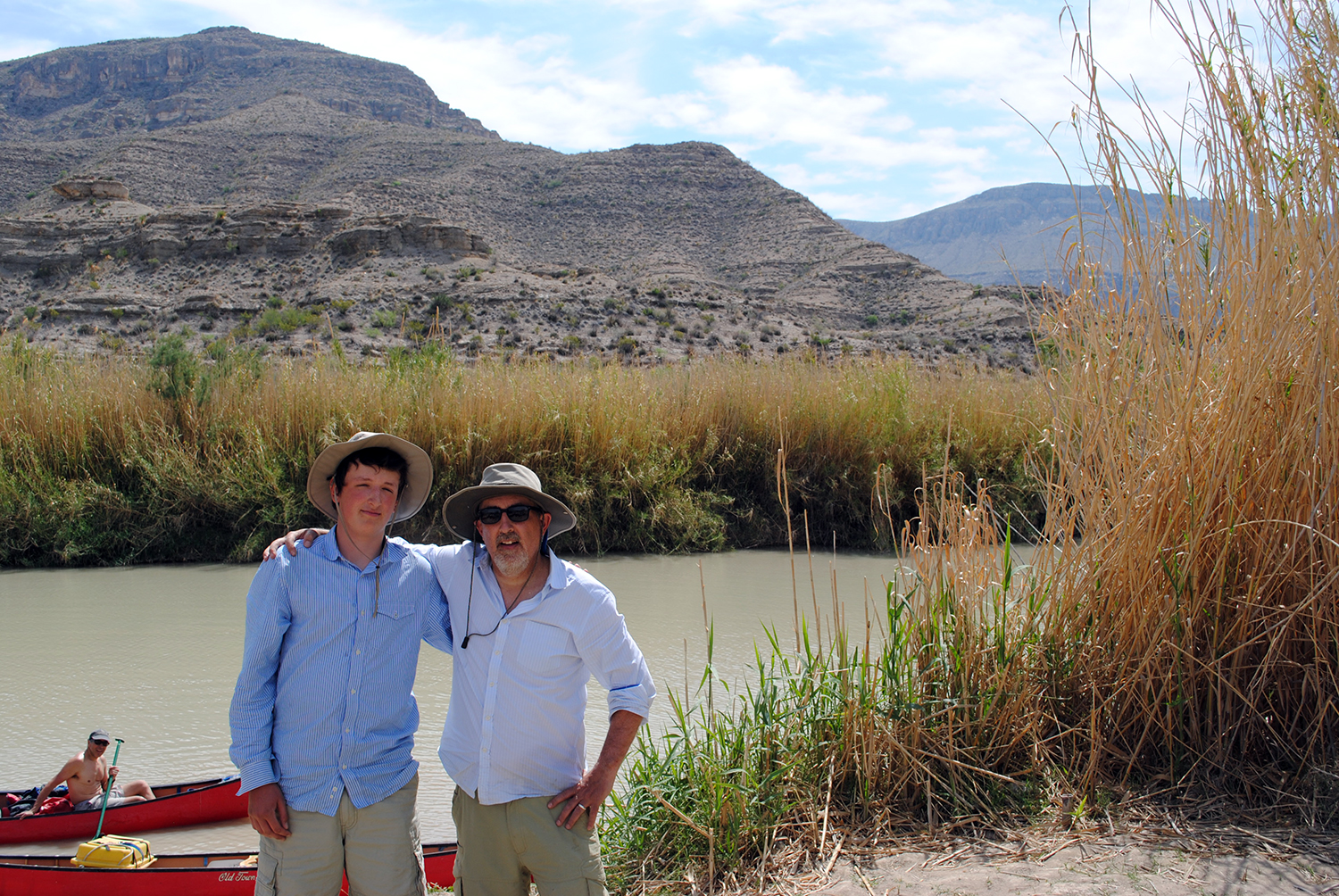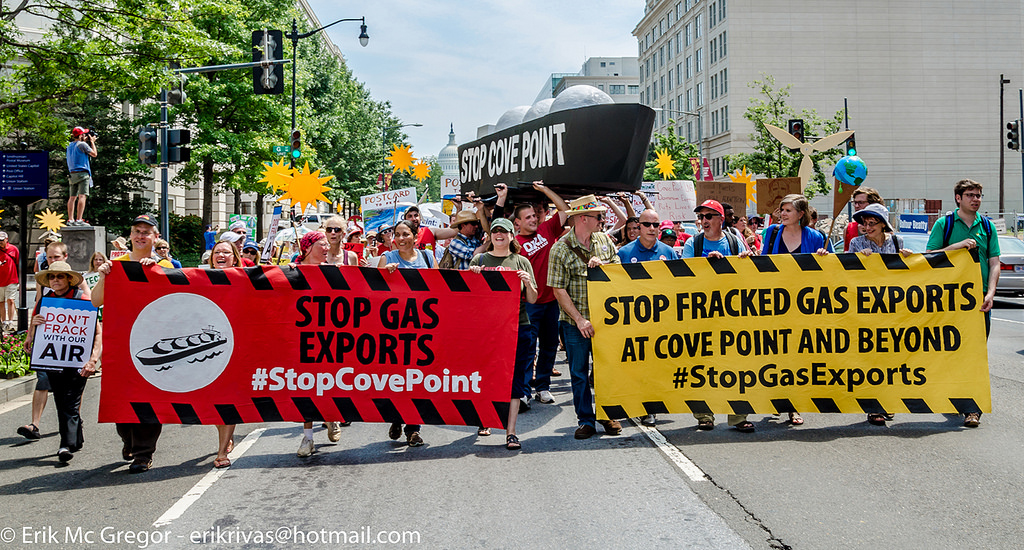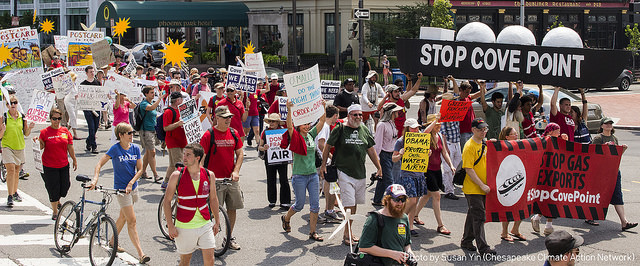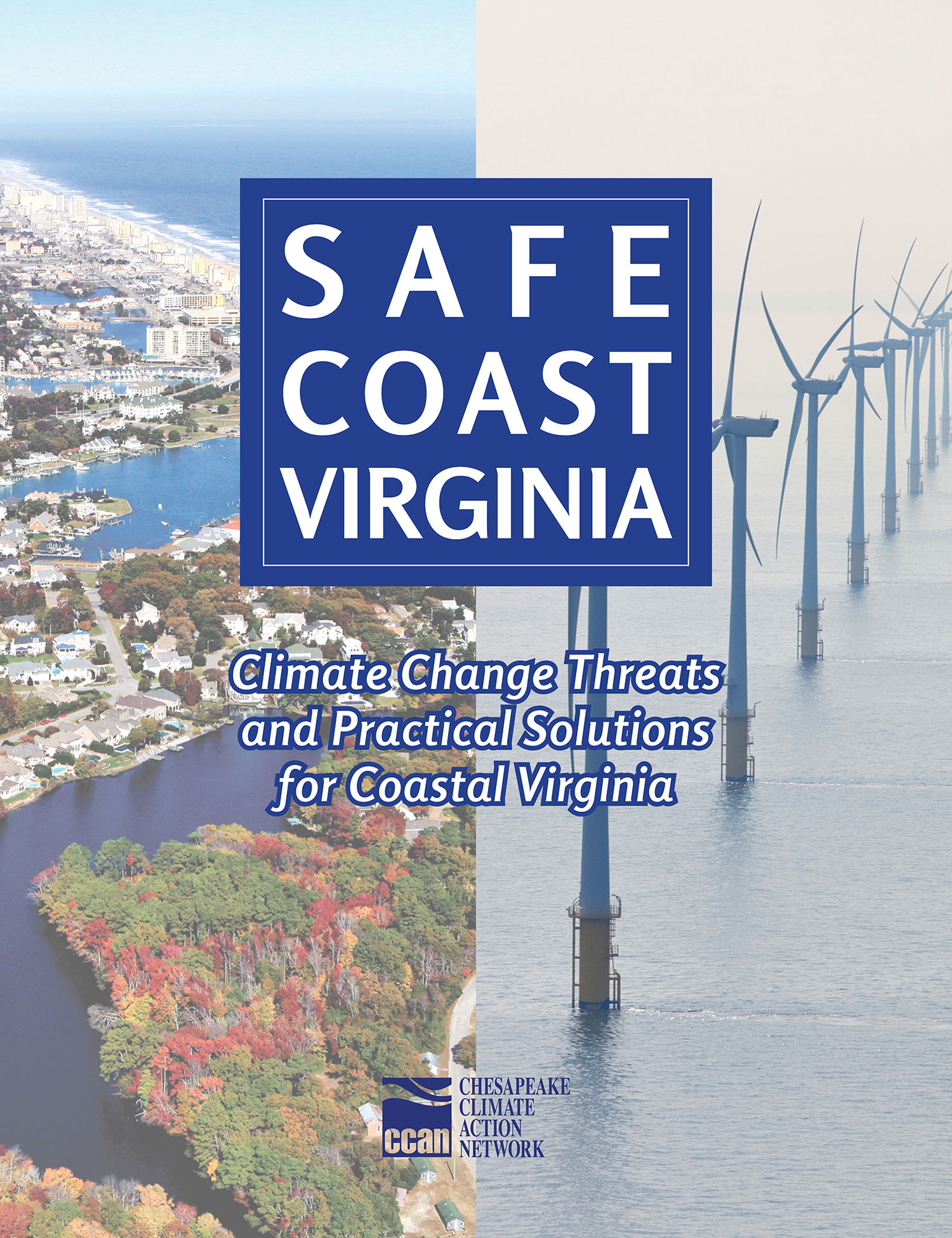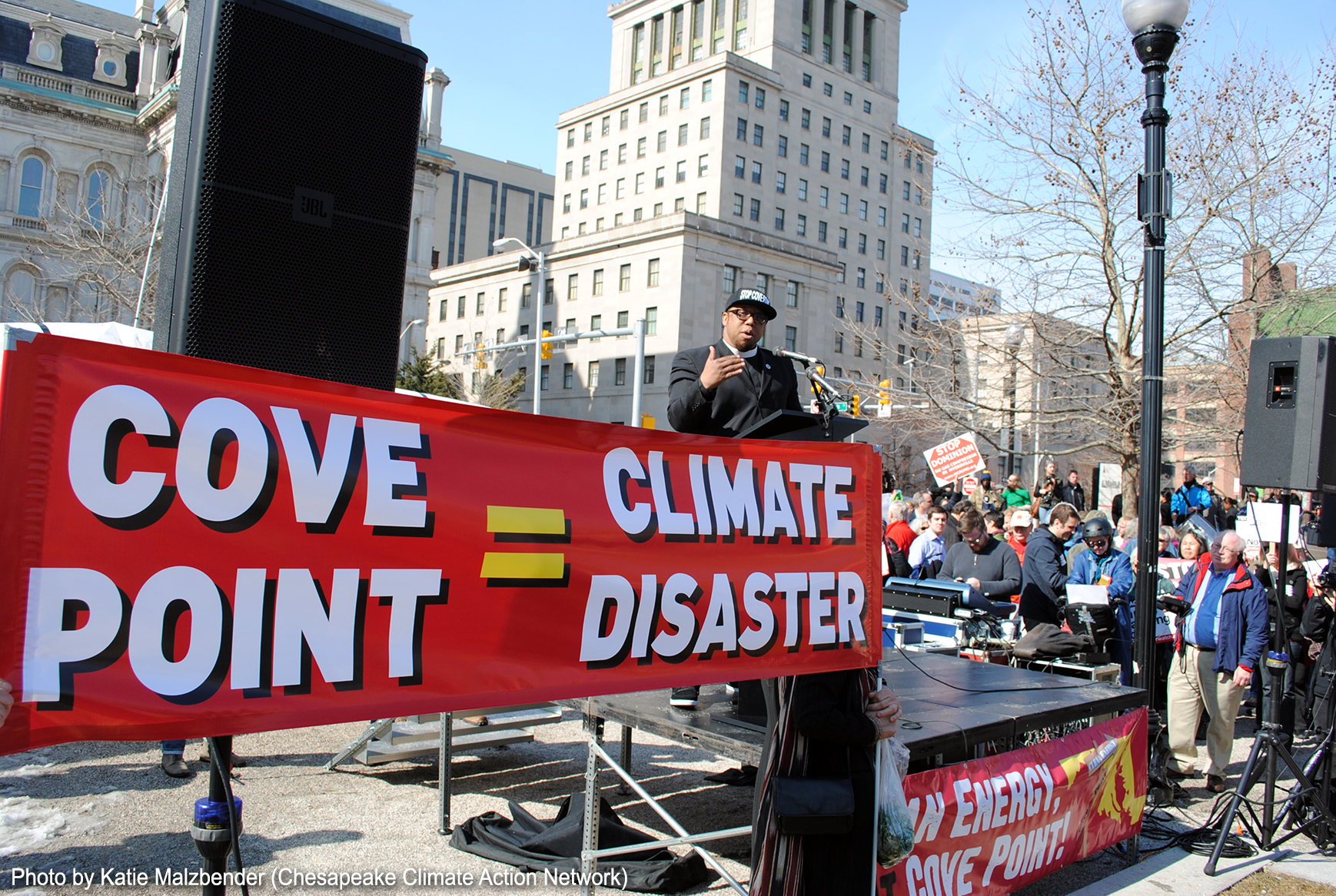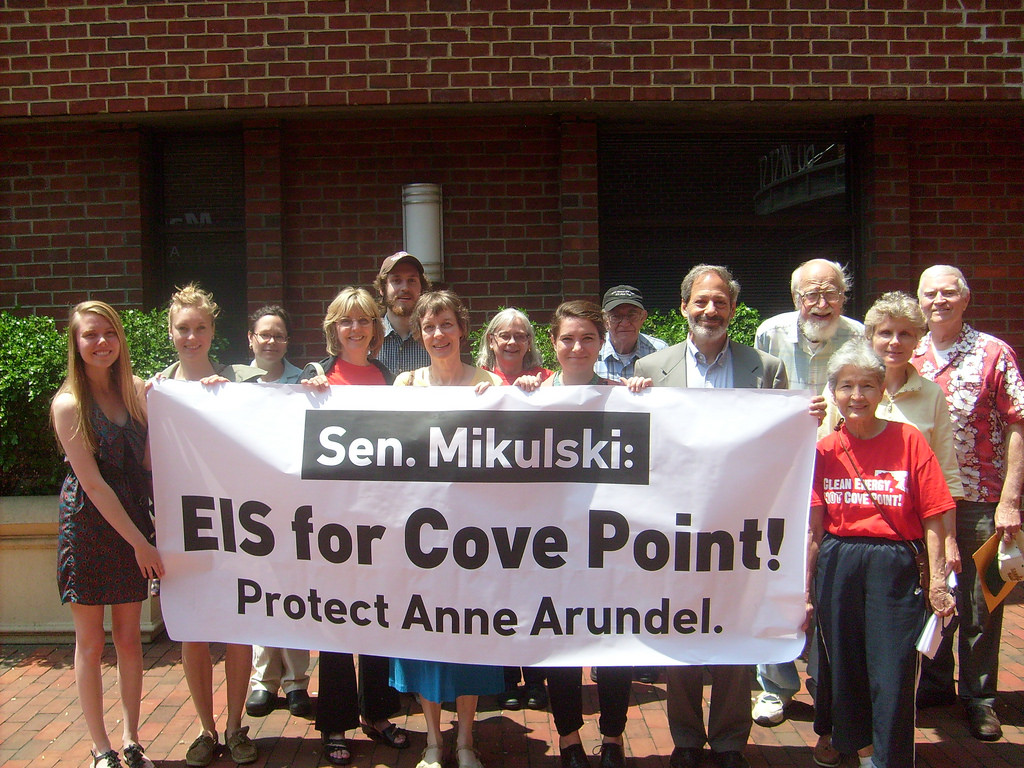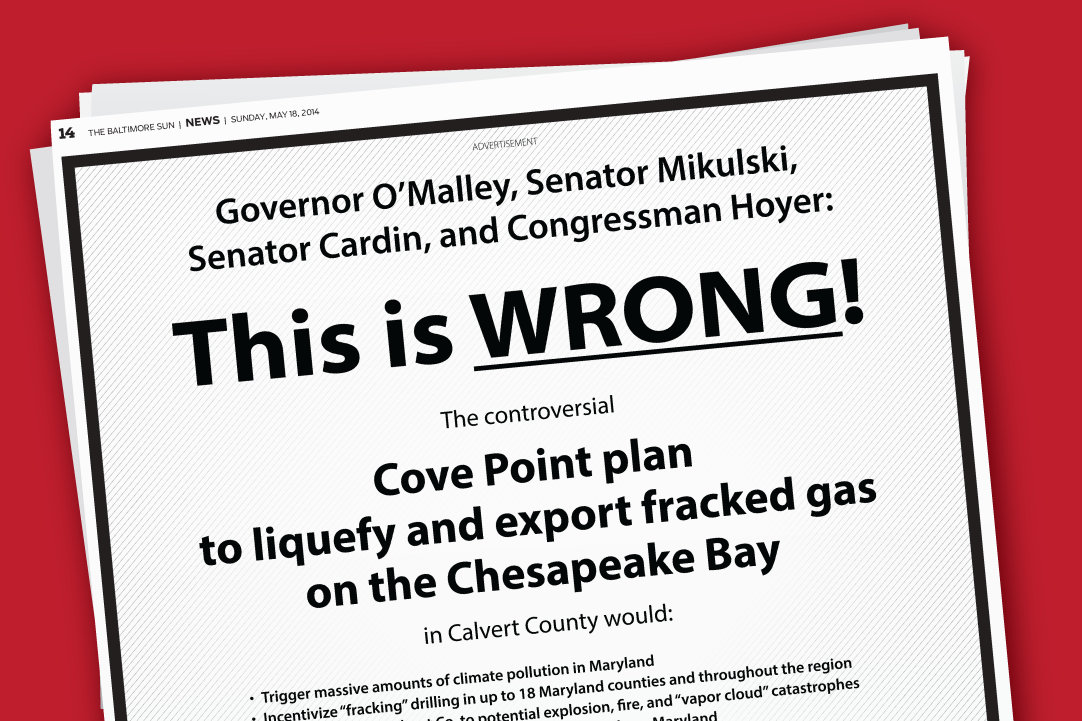I joined CCAN’s staff three weeks ago today and since day one I’ve been inspired by the “it ain’t over ‘til it’s over” spirit the community members we have the honor of working with bring to their work. That spirit is nowhere more visible to me than in the work of the Calvert Citizens for a Healthy Community, the citizen group that formed in opposition to Dominion Virginia Resources proposed liquefied natural gas export facility at Cove Point.
CCAN’s Southern Maryland Organizer, Jon Kenney, and I spent Monday in Calvert County, meeting with some of the leaders of CCHC. Inspired by last Sunday’s rally and undeterred by the construction work that has already started on Cove Point Road, CCHC’s leaders are ramping up their call on Governor O’Malley to step in where federal regulators have failed to and order a Quantitative Risk Assessment (QRA). A QRA is a basic and customary type of safety assessment that would determine the extent to which an accidental explosion or other catastrophe at the plant could put CCHC’s members and their neighbors in danger.

The reality of what’s at stake if the Governor ignores the citizens of Calvert County really hit home for me Monday. Jon and I went for a drive through Cove Point Park – a beautiful park that shares a fence with Dominion’s plant. Jon told me that this park – with its two playgrounds, baseball diamonds and crowded water park – is the place where kids in Calvert County go to play. And it shares a fence with the plant. Imagine the horrific scene if there were an explosion like the one that occurred at an LNG facility this spring in Plymouth, Washington.
And I met Leslie Garcia, one of the creative minds behind CCHC. With her husband, Leslie has been putting blood, sweat and tears into renovating their home – a home I had a hard time leaving after an hour, let alone 20 years. They feel like they’ll have no choice but to leave if Dominion wins. They’re in Dominion’s backyard: their home is less than a 5 minute walk from the overlook facing Dominion’s current import platform and a short drive from the plant. Imagine locking the door and walking away from the home you’d hoped to live the rest of your life in because you know that staying is too dangerous.

Before leaving, we walked along the pier at Solomon’s Island, looking out over the scenic Patuxent River towards the Thomas Johnson Bridge – Dominion plans to build a temporary pier next to the bridge for the loading and unloading of construction materials. And right next to it, one of the largest, most productive, and most beautiful farms in Calvert County – Dominion plans to use the field abutting this farm for the loading and unloading of construction materials coming off of the pier. Imagine the scene.

As we drove through neighborhoods on our way home, we noticed that a bunch of the old Cove Point lawn signs (“Cove Point: We need answers!”) had started to disappear. The construction work on Cove Point Road has gotten some folks started thinking this fight is over; Dominion has already won.
But the members of CCHC will tell you that it isn’t, that too much is at stake to stop fighting now. Just a few days after our visit, CCHC members traveled to Annapolis to join 52 organizations and residents for a press conference urging the Governor to protect the safety of Calvert County residents and order a QRA. As the fight against Cove Point continues, CCAN will be supporting CCHC at every step – whether that’s on the streets, in the media or in the courts – and what an honor it is for us to do so.
Rite of Passage
This is a feature story in the summer issue of Orion magazine.
Sometimes travel is mandated, sometimes it is endured, but often it is undertaken for the sheer pleasure of seeing new places or visiting old friends. Sometimes we travel on foot, sometimes by plane, sometimes all it takes is a book or a good imagination to carry us away. What does travel mean, and how does it shape the course of a day or a lifetime? This spring’s double issue of Orion includes a special section exploring the idea of the journey, and we’re pleased to share one of the features with you here. To read the full special section, six features in all, subscribe to Orion and let the journey begin.
ABOVE THE ROCK canyon wall, the sun winks into morning view, drowsy and golden. The light pours onto the mute Rio Grande, soon finding our tent just yards from the bank. The slanting rays gradually find the sleeping face of my son, Sasha.
He’s fifteen years old. Not quite a man, but almost. We’ll be visiting colleges this time next year. He’s not a boy, either, although he looks consummately boyish in the innocence of slumber. I see the Little Leaguer in his face, and the kindergartener. In sleep we catch the last youthful poses of our children.
And at this moment, I wonder yet again why I brought Sasha to this wilderness place. Part of the answer is simple. I’ve traveled the world—the Amazon, the Serengeti, the Alps—and for me this is the most haunting and beautiful landscape on earth. We are in absolute backcountry: the Chihuahuan Desert canyons of “Big Bend Country,” literally that giant bend of the Rio Grande that separates west Texas from northern Mexico. The same sun washing over Sasha’s closed eyes is rousing the cliff swallows into song two hundred feet away. Around us, a million desert flowers go all electric in late-March bloom—red ocotillo, purple verbena, the magenta blossoms of cholla cacti. In the riverbank shallows, a longnose gar sloshes though the willow grass, hunting frogs.
Quietly, I slip out of the tent and catch a glimpse of a desert hawk winging hundreds of feet overhead, above the canyon. From up there, that hawk can see the nearby Chisos Mountains to the northwest, towering to nearly eight thousand feet with the deep-green cover of alpine woodlands. Below the peaks, that hawk can see the vast expanse of desert floor, all cactus and scrub, spreading north, south, east, west. And arching through it all is the pale green ribbon of the Rio Grande. But what that hawk doesn’t see are very many human beings.
I discovered the place fourteen years ago by accident. A newspaper editor asked me to visit Big Bend National Park, the twelve-hundred-square-mile jewel on the Texas side. The editor’s question: Why do so few Americans visit this most lovely of places? The reporter’s answer: It’s at the end of the earth, not on the way to anywhere, and surrounded on three sides by harsh and hostile Mexican desert.
But it’s beautiful. Shockingly so. And therein lies the problem in bringing my son—still-sleeping Sasha—to this place. It seems almost cruel. So many of the living things we’re here to celebrate, all across this landscape, are stressed out, dying, or migrating away from here. Like politics, all global warming is local. By roasting our common atmosphere with greenhouse gases, we bring chaotic change to regional ecosystems like the Big Bend region. Here scientists and fifth-generation ranchers and native people all tell the same story: unimaginable recent heat waves, freakish cold snaps and, above all, drought.
Just since I was last here—when Sasha was in diapers back home in Maryland—the place has changed. The pinyon pines in the Chisos range had not yet experienced “mass mortality” due to chronic lack of water. And the lechuguilla, a signature species of the desert, had not yet been flash frozen in huge numbers during the unheard-of cold spell of 2012. When Sasha is my age, fifty-one, this ecosystem will almost certainly be a distant memory, barring some global clean-energy miracle in the next few years, a rescue that seems less likely with each passing month of international inaction and domestic denial. So I struggle: Is this healthy? Is it right what I’m doing here, bringing Sasha to this place?
That morning in the canyon light, I’m bird-watching from the riverbank when the brightening day finally wakes up Sasha. “Hey, what’s for breakfast?” he asks. I hear his sleeping bag unzipping, his teenage voice turning to his favorite teenage subject: food. “Eggs and tortillas,” I say. “Outstanding,” comes the reply.
Within an hour we’ll be in a canoe, paddling through this still-rich land where the lechuguilla and pinyon pines are trying their best to recover and the roadrunners and tarantulas and mountain lions are all still here in good numbers, despite recent climate shocks. The Big Bend region, like the Amazon rainforest and the Great Barrier Reef, is an incomprehensively vast ecosystem still teeming with the life of the Holocene and our nearly twelve-thousand-year run of stable climate. Over 450 species of birds—more than in any other U.S. park—still live or pass through Big Bend National Park.
But we’re not voyeurs here, drawn to that shortsighted product of the global travel industry, see-it-while-you-can tourism. We’re here to see it, yes. While we still can, yes. And to bond in the delights of desert camping. But for me there are deeper, more elusive motivations. I have come to the place I love most in the world, with the person I love most, in order to . . . what? Apologize? Ask for forgiveness? Find some new hope in an unexpected fresh insight? All of the above? What, basically, do we say to our kids in the face of astonishing loss in the natural world? How much of that loss do we even want them to know about, to discover and love, as it changes and exits? What do we owe our kids? What do we owe these places? How do we even talk about all this?
WHEN SASHA WAS four years old, in 2001, I walked away from a twenty-year journalism career to become a full-time activist on global warming. The transition was not easy for him or me. I launched a nonprofit organization, raised money, hired staff, and worked nearly nonstop. Frequently reporters would call me at night or on weekends to discuss the latest terrifying scientific study on Arctic ice melt or rising storms. More than once I hung up the phone only to finally notice my little boy, fire truck in hand, looking up at me from somewhere in the room. “Are we all going to die, Daddy?” he’d ask.
“No way,” I’d say, swooping down for a hug. “No way. We’re going to fix this thing, I promise.” And off he’d go, building another Lego house, with windows and chimneys and always—always—lots of solar panels on the roof, just like our house. He assumed all homes had solar power. He assumed all dads talked on the phone about the end of the world, and then said not to worry.
It was a schizophrenic time, those early days of parenting and climate activism. I tried to manage Sasha’s relationship with nature, discouraging him from watching in-depth nature programs on TV, not wanting him to fall too much in love with all that. But we also hiked and camped and fished, a lot. I took him to the woods whenever I could. It’s my passion. And all his life Sasha heard me talk about Big Bend country. About this desert ideal in faraway Texas, and how I was going to take him there one day.
And then that day came. Sophomore year of high school. Spring break. Better go now before girls and college and career intervene. So we loaded up the backpacks, bought carbon offsets for the long trip, and boarded a flight at Reagan National. New sunglasses dangled from straps around our necks. High above the plains of central Texas, however, with nary a cloud below our plane, I realize something: I don’t have a plan for unspooling the big messages I had assumed—and hoped—would come from this trip. Thankfully, they began unspooling themselves.
“Look at that,” Sasha says, pointing to hundreds of pumpjack oil wells spread thousands of feet below us.
“Nineteenth-century energy,” I tell him.
“And what’s that?” he asks, pointing to an apparent matrix of rocket launchers.
“Fracking for gas,” I say. “Twentieth-century energy.”
And then, further west, I spot the series of awesome white lines, full of spinning giant blades. “Your century, Sasha,” I say, as the wind farms pass below our plane, working with haughty gracefulness in the Texas breeze. “Yours.”
We finally land in El Paso, along the northern edge of the Chihuahuan Desert, and head southeast by car. Tiny ranch towns soon give way to nothing but creosote bush and towering yucca, dust devils and lost burros. When the two-lane state roads finally run out five hours later, we enter Big Bend National Park. And it’s everything I remember.
“Did I exaggerate? Did I exaggerate?” I ask my son. He’s too busy shooting photos to talk much. The camera spoke softly, click after click, as giant agave plants float into view in golden, brittle poses. Then come the arroyos, violently beautiful in the distance, carved by a million flash floods. Then the Chisos Mountains, phantomlike, forested, painted in shadows. Click. Click. Click. And then swaths of red-blooming Indian paintbrush, punctuated with javelina tracks and the den doors of a strange desert rat that miraculously never, ever, drinks water. “You did not exaggerate,” Sasha says.
The camera’s clicking is a memory cue for me, reminding me of a speech Bill McKibben gave in 2005, addressing a group of climate activists gathered at Middlebury College. “Fight like hell,” Bill told us. “But be a witness, too. Go see the whales, the rainforests. There’s no guarantee we’ll save them all. Memorize this great world, the one we were born into. Tell others in the future. Their mistakes might be fewer if they know the greatness we once saw.” This had always been a central if unspoken part of this trip to Texas, of course. And it explained most of the trips to the woods during Sasha’s childhood. Be a witness, my child. Don’t forget these things.
And so on our first full day at Big Bend National Park, we race to the top of the highest mountain, Emory Peak, and toss off our backpacks. There, from nearly eight thousand feet, we look down on an absolute kingdom. It tumbles and flows below us, down from a crown of pinyon pines to a robe of scrub oaks and desert flowers to a labyrinthine floor of cactuses stretching to the Rio Grande and off into Mexico. We are at the summit, Sasha and I, at last, where mountain lions roam amid rare Carmen Mountain white-tailed deer.
And if only it had ended right there—if only the story had been exclusively about life that day, and not also death. But the path back down the mountain does not lie. It meanders past bright-orange metal signs put there by rangers: FIRE DANGER EXTREME and HIGH RISK OF WILDFIRE. Sasha photographs these too. Click. Click.
The first decade of the twenty-first century was one of the driest in Texas since record-keeping began. And 2011 was the driest single year of all for many parts of west Texas. Like a vise, the trend of severe drought, intensifying over the last half century, is clamping down here. Scientists say rising temperatures are to blame. The hotter it gets, the greater the evaporation, sucking moisture and life right out of the land.
I hear the sound of cracking twigs and crumbling pine bark under our boots as we walk through our first long stretch of dead woodlands that day. It is worse than a graveyard. The bodies are unburied: bleached pinyon torsos countless and eerie all around us. They fill narrow valleys and cover the tops of foothills in vast patches amid the still-green survivors. The dieback of these pines is happening all across the American West, affecting everything from black-chinned hummingbirds to black bears. At the edge of one maze of dead trees, we break for water. I had worked up a little speech for years. “Remember when you were little,” I say to Sasha, “and how I always told you we were going to solve global warming?”
“Yeah,” he says. I pause and then tell him, for the first time, about McKibben’s speech. Sasha is ready, I figure. Fifteen years old. “The wind farms just aren’t coming fast enough,” I say. “We’re going to lose a lot on this earth.”
But like Santa Claus and sex, we both know he’s understood the truth long before. It’s good to have it out of the way, nonetheless. “Yeah, I know,” he says, packing up his camera, ready for the final hike down to camp. “And I’ll remember,” he says. “I’ll remember.”
SASHA IS A WONDERFUL son: honor student, junior varsity baseball pitcher, Eagle Scout. Best of all, right now, he’s totally into this intense and adventurous trip west with his dad. But he’s still a teenager. Ten months earlier, right before turning fifteen, he told his mom and me not to bother getting him a birthday present if it wasn’t an iPhone. If we loved him, he said, we’d get him one. So we got him an iPhone.
After sunset, lying on our backs below a brilliant desert night sky, billions of stars above, the hallelujahs fill my ears as if from a choir. Sasha and I are side by side, stunned into silence by the celestial display. And his phone has no signal. None. Blessedly. For the entire week. Same with mine.
So we are able to float, undisturbed, into the infinity of outer space. That’s what it feels like on a moonless night in west Texas. It’s not stargazing here. A dense curtain of brilliant dots is pulled from horizon to horizon, each dot saying, “Touch me. Touch me.” At night, lying here on your back, you are in outer space. We spy a blinking satellite. We find Saturn, Orion’s belt, and Cancer. Ursa Major leads us to Polaris, the North Star. “Whoa!” I say, pointing to another impossibly long shooting star.
It’s midway through our journey, and this has always been part of the plan: to show Sasha the best star display in America and perhaps the world. It’s a counterweight—timeless, cosmic—to the earthbound challenges and intermittent sadness of this one desert expanse on a tiny planet in a lonely solar system. I can feel the cool sand against my back. “Is it bad,” Sasha asks, “that I wish I were watching March Madness basketball right now?” He pulls out his phone. “Don’t you wish we could know the scores?”
IF YOU WANT to take the long view of matters here and yonder, then Ten Bits Ranch is one of those word-of-mouth places worth wandering into. A self-styled eco-refuge just outside the western border of Big Bend, it’s run by two geologists who are also amateur paleontologists and off-the-grid enthusiasts. Solar panels power the whole ranch, including the lamps in the cantina that light up an amazing collection of dinosaur bones under glass. There are vertebrae from duck-billed hadrosaurs and tail bones from mammoth Jurassic crocodiles, all found on the five hundred acres here. We’ve come to Ten Bits to wash up between camping trips and to learn about low-carbon life in the desert. But mostly we’ve come to explore a mysterious cliff dwelling on the property, used by Apache, Comanche, and older Archaic tribes for millennia.
It’s another cool, blue-sky morning in the desert when we leave our cabin, walking past bleached cattle skulls nailed to fence posts. The ancient Indian settlement is a quarter mile away, up a gentle slope along the southern side of a low mountain. Our hearts are pounding as we scramble past the final few boulders and red-blooming ocotillo to arrive at this unmarked and little-visited place. The shelter is simple and primitive, consisting of a long, deep rock overhang. But evidence of habitation is everywhere, including cylindrical mortars in the rock floor, worn in from centuries of pounding grain with hand-held pestles.
We stand on the ledge, facing the distant Rio Grande, and imagine the people who once lived here. The south-facing overhang was for winter shelter, anthropologists believe, offering protection from the cold north wind. In summer, it would have been too hot here, too exposed to sun. I think of all those people. All those winters. They slept, daydreamed, argued, laughed, made love, belched, snored, and cried right here—for thousands of years, with only a crude shelter from wind, a bad shelter from rain, and no shelter from cold.
Reflexively, I begin looking for an arrowhead. I always do whenever I think I have any chance. I scatter small rocks with my toe. I peek under boulders. I talk while I hunt, trying to stay on message. “The thing is,” I say to Sasha, “this climate change we’re seeing worldwide is going to affect more than just plants and animals pretty soon.” His teenager impatience starts coming through. “You’re about to tell me life is going to get hard for all people soon, aren’t you?”
“Well, yes.”
“But that civilization will carry on somehow, even if it’s hard. These cliff dwellers endured under hard conditions.”
“Yes,” I say.
“Well here’s what I don’t understand,” he grumbles, standing on the ledge and pointing to Ten Bits Ranch in the distance. “See all those solar panels?” There were eighteen of them, polycrystalline, big, providing three kilowatts of power, enough to run a kitchen, lamps, a water well, iPods, all in the middle of nowhere. “Why,” Sasha asked, “can’t ExxonMobil just become the Exxon of solar? Can’t these companies make a profit building solar farms?”
“Yes.”
“So why don’t they do it and just get off of oil?”
“Because Exxon can make more money with oil right now. Bigger profits.”
“So this whole thing—Katrina, Sandy, drought—is about Exxon making slightly higher profits for a few more years until god knows what happens to the climate?”
“Yes.”
“Dad, how are you losing this debate?”
“We’re not losing it,” I say. “We’re just not winning it fast enough.”
“What’s it going to take?” he asks. “Just what in the world is it going to take?”
“I don’t know,” I tell him. “I don’t know.” I keep saying it. Until I stop saying it.
“Holy cow!” I shout. The stone in my hand is not an imposter this time. It’s not a mere triangle-shaped rock with coincidental sharp edges. It’s an arrowhead. Carefully worked. Chipped, flaked, pointed. I found an arrowhead.
THE WEEK, too soon, roams to a close as we head back toward El Paso, our dusty tent and backpacks stuffed in the trunk. I feel a restlessness lift from me. I’ve finally done it. I’ve taken my son to this place. And now I’ll never come back here again. I know it. Not me. I have my memories. I love those memories. Why risk them with another return?
“What?!” Sasha exclaims when I tell him this. He’s appalled. “You’re crazy not to come back. I’m coming back. And I’m staying longer. As soon as I can.” From the passenger seat, he’s shooting some final desert photos.
And then I see it in his face. He has the same bug I’ve had for a decade and a half, but in a different way. He just finished touring a beautifully imperfect place. A place in transition. But he’s not sad. He’s not bummed out, perhaps despite my best efforts. He has a different starting point than I do. Born in 1997, all he’s known is a fast-changing, impermanent earth. So the world seems less fragile to him, I think. More elemental. Rock, sky, sand, life. It will all be here whenever he returns. And, if pressed, I think he would call that hope.
All About Unity: THANK YOU and Onward from the Stop Gas Exports Rally
Wow. On Sunday, the heat scorching the streets of DC was palpable. But, even more so, was the passion and power of our movement. THANKS to everyone who turned out to say NO to fracking, NO to gas exports at Cove Point, NO to runaway climate change, and YES to real clean energy solutions.
Click here to check out all the photos on Facebook, and share them to spread the word!
We know the gas industry is all about division — blasting apart the rock beneath our earth, running pipelines through our towns, and further disrupting our fragile climate — now to ship the gas overseas for higher profit.
On Sunday, we showed that our movement is all about unity. We converged from New York, Pennsylvania, North Carolina, Ohio, Virginia, Louisiana, and beyond. We marched as people living upstream, downstream, and everywhere in between along the chain of impacts that would come from exporting fracked gas. Together, we made local and national news headlines1 — and we made history: the Federal Energy Regulatory Commission has, hands-down, NEVER seen over 1,000 people protesting at their doorstep! We sent a loud and clear message to President Obama and FERC that climate leaders don’t frack — and that we’ll be back.
Then, early the next morning, 25 brave activists added their own punctuation mark. After peacefully blockading the entrances to FERC headquarters for two hours, they were arrested demanding that FERC reject the liquefied natural gas (LNG) export facility proposed at Cove Point.
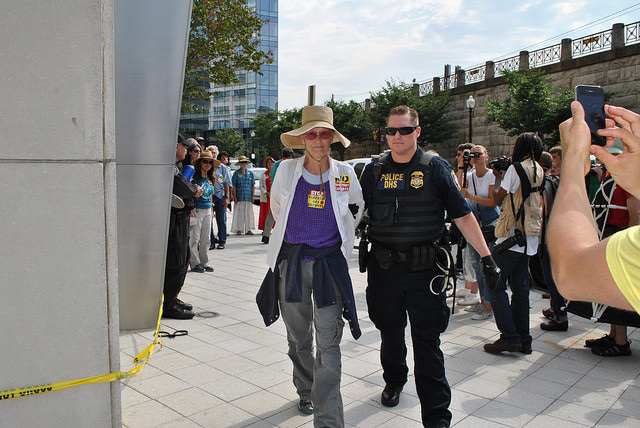
After such an inspiring few days of action, what’s the next step? First off, you can join the families of Calvert County, Maryland and demand an independent “quantitative risk assessment” of the worst-case explosion dangers of Dominion’s proposed Cove Point facility. FERC has refused to do this type of standard human risk study. Add your name to the petition calling on Governor Martin O’Malley to step in immediately and order one himself.
Beyond today, the immediate Cove Point campaign is likely to get tougher. We know it will take more than one or two powerful protests — or the record affordability of wind and solar power — to change the status quo at FERC or convince President Obama to reverse course on gas exports. This fight will almost certainly land in the courts, and involve more direct action in the streets. Stay tuned.
Ultimately, as we keep fighting together — and rocketing more stones of justice in Goliath’s direction — we do believe that we are winning. Ruth Tyson, the youngest speaker from the stage on Sunday, perhaps put it the best:
When I look out into this crowd, I see something a million times stronger than any current. I see something that Dominion [the company proposing to build Cove Point] should be afraid of. I see passion, commitment, hope, and love. … And because we all chose to stand up to a system of bullies and doubters and cowards, the direction of our current is changing.
Keep our current moving today: Click here to spread the word about Sunday’s powerful protest. Click here to sign the urgent safety study petition to Governor O’Malley.
Finally, click here to pitch in today and support CCAN as we continue building this people-powered movement.
–Much love from Mike Tidwell, Shilpa Joshi, Ted Glick, and the entire team at the Chesapeake Climate Action Network
1. Check out news coverage in WUSA TV, Politico, The Nation, Al Jazeera America, Reuters, EcoWatch (including Sandra Steingraber’s powerful speech), the Baltimore Sun, DeSmogBlog, and more!
Community Organizing to Stop Cove Point
It was an amazing moment. I was a block away from the march when I could hear “Stop Cove Point!” echoing off the hot pavement in Downtown DC. I ran over to join the 1000+ activists from the Eastern Seaboard as we marched from the National Mall to the headquarters of the Federal Energy Regulatory Commission, or FERC.
As I approached the front of the march, I started recognizing the group of Calvert County residents I’ve been working closest with over the last few months fighting Dominion Resources’ proposed fracked gas facility at Cove Point. One by one, they started to come into focus within the sea of people. Some were holding signs, marching with their children, and carrying creative artwork (which included a huge LNG tanker and giant postcards to FERC).

Some were even holding banners marching next to movement leaders like Tim DeChristopher and Sandra Steingraber. A few months ago, this was probably the last thing these Southern Maryland marchers thought they would be doing on a sweltering day in July.
These people are part of the hundreds of concerned citizens from Southern Maryland that live within a few miles of Dominion Resources’ proposed Cove Point gas export facility. Most of them were first learning about the plant just last fall, whether it was at a town hall, or a discussion with their neighbor while they walked the dog. They formed a group, Calvert Citizens for a Healthy Community (CCHC), which has been courageously fighting off the goliath-like Dominion from relentless propaganda on TV, radio, and print, pushing to stop the plant from tarnishing their idyllic bayside community.

The members of CCHC have been integral in making this rally, and this movement, grow so quickly. CCHC has been a big part of the campaign every step of the way. They’ve collected hundreds of public comments, going door-to-door and calling neighbors throughout the community, pointing out the glaring safety and environmental flaws on FERC’s draft environmental assessment of Cove Point. They’ve published dozens of letters in the local paper, held house meetings, Gasland screenings and have lobbied elected officials. They’ve packed public hearings, outnumbering the proponents of the plant and giving passionate testimony. At the rally, we filled an entire bus with Southern Marylanders, and a CCHC member kicked off the rally as an incredible speaker, sharing her story with the large crowd and the media.
Every day, I am inspired by the sheer amount of work and effort the CCHC members have given to this fight; spending endless hours late into the night researching detailed applications and documents, writing countless letters to elected officials and newspapers, attending weekly public meetings, sitting in on panels and sharing their story on national activist conference calls. They can’t stop, and won’t stop, until the job is done and they stop Cove Point from being built.

It’s been an amazing journey, and, while I know it’s definitely not over, it’s the members of CCHC that give me hope. Not only have we built a formidable grassroots opposition to the proposed project, but have also built a community and network of lifelong friends that can now provide a support structure for each other in the face of such an uphill struggle. I don’t think Dominion had any idea of who they were messing with when they submitted their application to FERC.
While I was marching alongside my friends from Southern Maryland yesterday, I came to the conclusion that without a doubt we will stop Cove Point, and we’ll look back and see that all of the hard work was worth it. At the very least, it will make for a great victory party.
Safe Coast Virginia: Report Offers Bold Flooding and Climate Action Plan
Today the Chesapeake Climate Action Network released a report — Safe Coast Virginia — that details the climate change threats facing coastal Virginia and outlines ten bold but practical solutions for addressing them.
Click here to view and download a PDF copy of the report.
Click here to read the news release.
Coastal Hampton Roads is already ground zero for climate change impacts in Virginia. By the year 2100, sea levels are projected to rise by as much as seven feet or more, substantially higher than average global projections. That places much of Tidewater Virginia second only to New Orleans and Louisiana’s Gulf Coast as the largest U.S. population center at greatest risk of flooding and largely disappearing. But Hampton Roads also has an opportunity to be a ground zero for solutions.
Safe Coast Virginia lays out 10 important solutions that are within the reach of Virginia’s citizens and policymakers right now. These solutions can make Virginia a leader in reducing (“mitigating”) the actual source of climate change and sea level rise: greenhouse gas emissions. These solutions could easily make Virginia a global market leader in the growing clean technology sector. These solutions include realistic and necessary approaches to adapt and protect Virginia’s coastal communities from the rising tides and extreme weather impacts that can no longer be mitigated.
Top among the report’s policy proposals is a win-win solution that’s new to the policy discussion in Virginia: participating in the Regional Greenhouse Gas Initiative (RGGI). This cooperative effort among nine eastern states from Maine to Maryland reduces greenhouse gas emissions through a cap on carbon emissions. By participating in this regional program, Virginia could reduce planet-heating emissions while raising hundreds of millions of dollars in dedicated funding for coastal adaptation. Indeed, the report finds that Virginia could raise up to $200 million annually by 2020.
Read the Safe Coast Virginia report here. Then stay tuned for ways you can help make these solutions a reality for Virginia.
Fracked Gas Exports: A Climate Disaster
Even as the facts about liquefied natural gas (LNG) exports get harder and harder to ignore, the Federal Energy Regulatory Commission (FERC) continues to bury its head in the sand. Last month, a Department of Energy study revealed that — even when using conservative estimates of harmful emissions — exports of US fracked gas to Asia provide absolutely no climate benefits for decades, if ever. In fact, exporting natural gas is worse for the climate over the next critical 20 years than if Asian countries burned coal overseas!
FERC wants to ignore this fact and rubber stamp the gas industry’s proposed export projects, but FERC is being met with a sea of opposition. Next week, opponents of FERC’s traditional cow-towing to fossil fuel interests will raise their voices on FERC’s doorstep using a tactic successfully employed by past social justice campaigns, ranging from women’s suffrage to civil rights: The picket line.
Each day during the week of June 23-27, from noon – 1:30pm, groups of concerned citizens from the region will descend upon FERC’s headquarters in downtown DC, just a block from Union Station. With signs and chants, we’ll highlight FERC’s wrongdoing in a whole new, unavoidable way — by picketing directly at their doorstep.
Sign up to join the first-ever DC picket line protesting Cove Point! Pick a day or two from 6/23-6/27, noon – 1:30pm outside of FERC headquarters in downtown DC.
And the timing couldn’t be more crucial. Earlier this year, President Obama made it clear that climate change is here now, and its impacts are already being felt across the nation and around the world. Then, on June 2nd, the Environmental Protection Agency released some of the most significant climate regulations we’ve seen yet, laying out requirements for each state to limit greenhouse gas emissions from power plants. The new regulations are an important step forward that could help promote the transition to cleaner energy across our region.
To achieve that switch, however, we need to address the 800 pound gorilla in the room: fracked natural gas. The studies are clear: a global shift to reliance on natural gas fracked from deep below the earth could be equally as bad, if not worse, for the climate than continued reliance on coal.
The natural gas industry has been selling the public a bill of goods. For years, they’ve tried to sell their product as a “bridge fuel,” a clean alternative to coal and oil. But now data from the DOE itself shows this is not true, especially when the gas exported to Asia. And FERC has yet to change course.
Enough is enough.
Join thousands of climate and anti-fracking activists on July 13th in an historic march on Washington on to say NO to FERC’s tradition of giving the gas industry what it wants at the expense of our climate, economy, and safety.
It’s abundantly clear that solving the climate crisis will require keeping gas in the ground — along with the tar sands, the coal and the oil.
The gas industry spends billions on ads touting natural gas as 50 percent cleaner than coal.Gas is cleaner only at the point of combustion. If you calculate the greenhouse gas pollution emitted at every stage of the production process — drilling, piping, compression, shipment to Asia — it’s just coal by another name.
Earlier this week, Karen Feridun of Berks Gas Truth wrote a great piece about the attendant risks that come with the increased fracking we know will result if any of the more than 20 proposed natural gas export facilities are built. Fracking poses safety risks to local communities as harmful chemicals are released into the air and water. It also triggers the start of a chain of climate pollution.
In the process of fracking, piping, and liquefying natural gas, the Environmental Protection Agency estimates that about 1.4% of natural gas escapes as methane into the atmosphere. Methane is 84 times more powerful at trapping heat in the atmosphere than CO2 over a 20-year time frame. Gas exports will increase the demand for fracking and transporting natural gas, meaning more and more climate polluting methane will be leaking into the atmosphere.
When you add it all up, gas export facilities like Dominion Resources’ proposed Cove Point plant would trigger global warming pollution that spells disaster for our climate; the cumulative, planet-heating emissions triggered would be equivalent to building more than 100 new coal plants or putting 78 million more cars on our roads.
But real alternatives exist. While we’re saying no to dirty fracked gas exports, Americans want to say yes to increasing our wind and solar power consumption and adopting policies committing us to more clean energy.
It’s time for the US to decide. Are we going to stay the course to a safe climate with bigger and better clean energy development, or are we going to move backward to dirty energy with fracked gas exports?
On Sunday, July 13th, here’s what’s happening: Tim DeChristopher, Sandra Steingraber, the Reverend Lennox Yearwood Jr., and anti-fracking activists by the thousands will gather for an historic national rally at the Capitol building. We’ll then march together — noisily, creatively, insistently — to the disgracefully pro-fracking Federal Energy Regulatory Commission (FERC).
We need you there, too. Join Tim DeChristopher, Sandra Steingraber, and citizens like you to protest fracked gas exports — July 13th in DC.
Our message to President Obama and FERC is simple: Fracked gas is not clean and exported gas harms our climate. It’s time to leave the gas in the ground and move on to real solutions like wind and solar power.
#StopGasExports: A Week of Online Action
This morning, the inbox of the Federal Energy Regulatory Commission is being flooded with tens of thousands of messages from people all across the nation saying “no” to fracked gas exports. Today is the final day to submit a public comment urging FERC to reject the “poster child” for a disastrous gas industry plan to export natural gas: the Cove Point terminal proposed just 50 miles from the White House on the Chesapeake Bay in southern Maryland. (You can click here to take action by the 5pm deadline.)
And while we’re flooding FERC’s inbox today, anti-fracking marchers will flood the streets outside of FERC’s headquarters on Sunday, July 13th. Why?
The short story is this: FERC is on the verge of rubber-stamping a massive expansion of fossil fuel exports — fracked gas exports — that would spell disaster for the climate. It would harm communities all along the chain of new fracking wells, pipelines, compressor stations, and gas “liquefaction” plants involved in the process. And, as the gas is exported overseas (almost entirely to Asia) gas prices would even rise here at home, meaning virtually all Americans lose while wealthy gas corporations profit. This is exactly the wrong direction for our country and for our climate — and that’s where you come in.
On Sunday July 13th, we take our grassroots movement for clean energy, not fracked gas exports, straight to Washington, DC. We know that the five-member FERC commission – appointed by President Obama – has a shameful track record of rubber-stamping virtually all gas industry projects brought before it. Now is our time to demand a change in course.
To spread the word, the internet will be abuzz this week with the Stop Gas Exports Blogathon. Every day through Saturday, movement leaders like Bill McKibben, Sandra Steingraber, and Rev. Lennox Yearwood Jr. and everyday fracking fighters will be blogging about different aspects of liquefied natural gas (LNG) exports and why they’re not the solution to our energy and climate woes. Follow #stopgasexports and www.stopgasexports.org for all the updates and to share with your friends!
To learn more today, check out the full run-down of frequently asked questions below.
__________________________________________________
[bs_collapse id=”collapse_a1f3-fc1b”]
[bs_citem title=”Why are thousands of Americans coming to Washington DC on July 13th?” id=”citem_3062-c96d” parent=”collapse_a1f3-fc1b”]
From the Chesapeake Bay to the Gulf of Mexico to the Oregon coast, the gas industry is proposing to build more than 20 LNG export facilities.If the gas industry has its way, it will ship so much carbon overseas it will be like building 100 new coal plants. Fracking wells and their associated explosion-prone infrastructure will proliferate. And over time it could double or even triple the current domestic price of gas.
As we call out the president for his support of fracking, we’ll turn up the pressure on FERC to protect the American public and stop being puppets to the fossil fuel industry. To date, FERC has approved virtually all oil and gas infrastructure proposals brought before it. That’s why we’re demanding change — thousands of Americans from areas affected by gas exports will say “no way” to more rubber stamps that subject more and more communities to expanding pipelines, compressor stations, export terminals and other fossil fuel infrastructure.
But we’re not just opposed to things, and we’re using our people power to push for the positive change we need. On July 13th we’ll proudly and loudly say “yes” to wind power and solar energy and efficiency investments. Wind farms don’t cause earthquakes. Solar panels don’t poison our drinking water. And energy efficiency doesn’t leak methane. But they DO create jobs and a stable climate.
[/bs_citem]
[bs_citem title=”Why is exporting natural gas bad for the climate?” id=”citem_9aca-e4b3″ parent=”collapse_a1f3-fc1b”]
Natural gas is mostly comprised of methane, a potent heat-trapping gas that can leak into the atmosphere at every stage of the drilling and export process. The gas industry has run an elaborate hoax, touting itself for representing the “clean” fossil fuel. But if you consider the full lifespan of exported gas, from fracking, piping and compressing it across America, liquefying it, shipping it 6,000 miles to Asia, and then regasifying it, piping it more and finally burning it, this process has a climate impact that is is as bad as — or worse than — burning coal! A recent study by the U.S. Department of Energy found that, over a 20-year timeframe (the critical window for tackling the climate crisis), LNG exports to Asia would likely be worse for the climate than if Asian countries burned coal. According to Climate Progress, “a close reading of the DOE report in the context of the recent literature indicates that exporting natural gas from the U.S. as LNG is a very poor idea.”
[/bs_citem]
[bs_citem title=”Who is responsible for approving a natural gas export facility?” id=”citem_77fb-52df” parent=”collapse_a1f3-fc1b”]
Before a natural gas export facility can be built, it needs a number of local, state, and federal permits. For Cove Point and other projects on FERC’s existing docket, the US Department of Energy (DOE) was responsible for first analyzing whether or not shipping LNG to countries where the US doesn’t have an existing free trade agreement is in our national interest. Then, FERC looks more specifically at the safety and environmental impacts of the project, based on standards laid out in the National Environmental Policy Act. In the case of Cove Point, FERC released an Environmental Assessment on May 15, and gave the public a mere 30 days to comment in return. In late May, DOE changed up the federal review process for future LNG export projects — DOE will now release its final public interest determination only after environmental reviews for proposed plants are completed.
Ultimately, President Obama’s administration needs to reverse its approach to these destructive projects. President Obama can’t meet his promises to solve the climate crisis by overseeing a massive expansion of fracked gas infrastructure that vents harmful methane into our warming atmosphere.
[/bs_citem]
[bs_citem title=”If there are significant risks involved, isn’t FERC obligated to reject these plans?” id=”citem_60f3-382e” parent=”collapse_a1f3-fc1b”]
Morally, yes. And, if FERC fully followed the law, yes. However, FERC has approved almost every project that the oil and gas industry has put before it, rubber-stamping several facilities that have gone on to have fatal accidents. Earlier this spring, a case brought against FERC by residents of Minisink, NY to challenge FERC approval of a compressor station, highlighted this track record. Attorneys for Minisink argued that FERC is “predisposed to sign off on projects.”
In many cases, FERC will “segment” its review of permits, considering individual parts of a gas infrastructure project to, in effect, disguise the cumulative environmental consequences. In another recent case, the DC Circuit court ruled in favor of the Delaware Riverkeeper Network, New Jersey Highlands Coalition, New Jersey Sierra Club finding that, in reviewing a pipeline expansion proposal, “FERC acted arbitrarily in deciding to evaluate the environmental effects of the Northeast Project independent of the other connected action.”
In the recent case of Cove Point, FERC’s Environmental Assessment swept the project’s many dangers under the rug, absurdly concluding that this $3.8 billion fracked gas export plan would have “no significant” impact on the environment or human health while failing to analyze its role in driving expanded fracking or the cumulative climate change pollution it would trigger. Unless FERC substantially revises its insufficient analysis, environmental groups will likely sue the agency for violating the National Environmental Policy Act.
[/bs_citem]
[bs_citem title=”Where are gas exports being planned in the US?” id=”citem_2676-5c60″ parent=”collapse_a1f3-fc1b”]
There are currently 14 U.S. LNG export facilities proposed to FERC, from Oregon to Texas to Louisiana to Mississippi to Maryland. In Maryland, the Cove Point terminal, proposed by Virginia-based Dominion Resources, would be the first fracked gas export facility on the East Coast, and the first facility located so close to schools, daycares, a public park, and many private residences. There are 4,000 homes within 2 miles of Dominion’s proposed export facility, and local residents are deeply concerned about an accident on the facility that could escalate into a major fire or other life-threatening event.
[/bs_citem]
[bs_citem title=”How do I know I won’t see the benefits of gas exports?” id=”citem_ab19-dd3a” parent=”collapse_a1f3-fc1b”]
If all the proposed LNG export projects in the U.S. are approved, the result would be the export of more than 40 percent of our current production of natural gas. This means more competition at home, and thus, higher prices for domestic consumers and industries. In fact, a study commissioned by the Department of Energy shows that exporting natural gas would harm every major sector of the U.S. economy — except the gas industry.
In the example of Cove Point, the Maryland Public Service Commission concluded that the “LNG facility will not provide net economic benefit to Maryland citizens,” despite granting Dominion a conditional partial permit. In fact, the 130 megawatt gas-fired power plant Dominion would have to build onsite to fuel the energy-intensive “liquefaction” process will provide ABSOLUTELY NO electricity for Maryland’s grid. That means we see all of the pollution and risk and none of the energy.
[/bs_citem]
[/bs_collapse]
____________________________________
Join the Chesapeake Climate Cruisers
For the third year in a row, CCAN members and supporters will take part in the 300-miles-in-five-days Climate Ride from NYC to DC, September 20-24. CCAN Board member Cindy Parker and I are signed up and getting prepared for this challenging but very rewarding biking experience.
There’s still time to sign up as a member of CCAN’s Chesapeake Climate Cruisers team. You can do so by going to http://climateride.org, learn more about the ride and what’s involved and then sign up.
In addition to being a long-distance ride through some absolutely beautiful countryside, the Climate Ride is also a fund-raiser. Participants need to raise at least $2,800 to participate, a majority of which goes to the group or groups which you designate as beneficiaries. The Climate Ride organization has lots of tips and ideas to help you meet that goal. For each of the last two years, CCAN has received about $10,000 to help us do our important work.
I was not a long-distance bike rider before I did my first Climate Ride in the spring of 2012. I did do bike-riding, mainly as part of my exercise routine. I rode about 8 miles three times a week. But as a result of the riding I did in preparation, and as a result of that first ride, I fell in love with long distance biking. Ever since I ride about 70 miles a week, sometimes more, doing so usually in early morning. I enjoy the rising of the sun, the singing of the birds, the animals, other bikers, runners and walkers I encounter and the good feeling that comes after a hard physical workout.
To begin to do this while in my 60’s has been like a special gift, something I would have never done if not for Mike Tidwell asking me if I wanted to join him on that ride.
I hope CCAN supporters who have not experienced the joys and the challenges of this sport, as well as those who are already avid bikers, will seriously consider joining Cindy and me this September.
I’m available if you have questions; you can contact me at ted@chesapeakeclimate.org.
A Big Month in the Cove Point Fight
The past month has been one of the most eventful yet in the fight against Dominion Resources’ proposed Cove Point fracked gas export facility. To help you stay informed as the urgency picks up, here’s a timeline of the important events and some of the media coverage this fight has seen recently.
May 6th: CCAN and Dominion shareholders file SEC complaint over failure to disclose potential investor risks in Cove Point.
On the eve of Dominion’s shareholder meeting in Cleveland, Ohio, (the site of a catastrophic natural gas explosion that killed over 200 people in 1944,) a Dominion shareholder and environmental advocates submitted an official complaint to the U.S. Securities and Exchange Commission (SEC) detailing how Dominion Midstream, a new gas export subsidiary of the larger Dominion Resources, has potentially omitted or inadequately disclosed significant financial and environmental risks of its proposed liquefied natural gas export terminal.
Learn more about the SEC filing:
- The Daily Record reported on the filing, pointing out that “Dominion was expected to begin construction of the facility during the first quarter of this year, but that has already been delayed.”
- CCAN director Mike Tidwell published a piece in the Cleveland Plain Dealer detailing the risks inherent in such a project.
May 15th: The Federal Energy Regulatory Commission (FERC) Released its Environmental Assessment (EA) of the Cove Point project.
After failing to consider a number of critical factors, the EA found that Cove Point would have “no significant environmental impact.” Immediately, Dominion celebrated the release of such an inadequate study that ignored local safety impacts of the project as well as fracking impacts and life cycle climate pollution.
Learn more about FERC’s inadequate EA:
- Why is the EA totally deficient? Check out CCAN’s Fact Sheet.
- Baynet quotes CCAN director Mike Tidwell on why we need a full Environmental Impact Statement for Cove Point
- DC Media Group reports that FERC Report on Cove Point Misses Big Picture with its Cove Point EA.
- Even oilprice.com asks if it’s the Wrong Time For This Natgas Project. –
- The Nation wants you to take action: Want to do something about Climate Change? Stop Cove Point.
May 18th: This ad runs in the Baltimore Sun, calling on Maryland’s legislators to demand accountability on the proposed Cove Point project.
May 21st: Members of Congress and Cove Point opponents request public comment period extension from FERC
A coalition of faith, health, and environmental groups came together to ask FERC for an additional 60 days to submit public comments on the Environmental Assessment, bringing the end of the comment period to August 13th. Senators Cardin and Mikulski also joined the call for an extension.
Learn more about the request for an extended comment period:
- Reuters reported that U.S. groups seek more time to comment on Dominion LNG export project
- The Calvert Recorder published Group files for FERC comment period extension on LNG project
May 22nd: Activists around the state visit Senators Mikulski and Cardin’s offices, calling on them to stand with Maryland and demand a full Environmental Impact Statement.
At each of Senators Cardin and Mikulski’s offices, activists assembled to speak with staffers and deliver a letter to the Senators detailing why Cove Point needs a more detailed environmental study and a full safety review.
Learn more about the action at the Senators’ offices:
- The Appalachian Independent covered the story of Frostburg State University students calling on the senators.
- Read CCAN’s press release about the day of action.
May 29th: U.S. Department of Energy (DOE) Issues Report Showing that natural gas is worse for the climate than coal when exported to Asia.
According to DOE’s own report, the “results show that US LNG is nearly as bad as coal when exported to Europe and worse than coal when exported to Asia when the climate impacts of methane leakage are measured over a 20-year timeframe.”
Learn more about the DOE report:
- Read CCAN’s summary of the DOE report and its implications
- ClimateProgress broke the news that LNG has no climate benefits now, if ever.
May 30th: The Maryland Public Service Commission delivered its decision about key permits for Cove Point.
The PSC granted Dominion a “Certificate of Public Necessity” for Cove Point that is contingent on the final decision from federal regulators and other conditions. In its report, the PSC noted that Dominion’s project would be a net negative for Maryland’s economy and asked the to pay to mitigate those impacts. The PSC asked Dominion to “include more safety and environmental protections for the controversial project, and to donate $48 million to promote clean energy in the state and to help low-income Marylanders pay their power bills.” (Baltimore Sun)
Learn more about the PSC’s decision:
- The Calvert Recorder quotes Mike Tidwell as saying “The PSC expressed concern for the safety of people living closest to the proposed plant but failed to actually protect these people.”
- The Baltimore Sun reports that the PSC “declared that the export terminal would not provide net benefits to state residents.”
May 31st: FERC held its one and only public meeting about Cove Point at Patuxent High School in Lusby, MD.
 At the hearing, which lasted over six hours, 100 people from across Maryland testified. Of those 100, 66 spoke out against the project, and 34 spoke in its favor. Many opponents of the project spoke about the safety risks it poses to local residents. Outside the hearing, opponents built a mock “sound wall” detailing the “air pollutants and carcinogens that Dominion’s proposed plant would routinely or accidentally send from its compound into the lungs of playing children and their parents.” (a tale of two walls) Among those who testified was 13-year-old Katie Murphy who brought tears to the FERC representatives’ eyes, calling on them to stop Cove Point and protect the nearby residents and plants and animals who would be hurt by the proposal. In one of the most notable testimonies of the day, a Dominion supporter began his testimony by calling for a full Environmental Impact Statement, a more detailed study than FERC’s flimsy EA.
At the hearing, which lasted over six hours, 100 people from across Maryland testified. Of those 100, 66 spoke out against the project, and 34 spoke in its favor. Many opponents of the project spoke about the safety risks it poses to local residents. Outside the hearing, opponents built a mock “sound wall” detailing the “air pollutants and carcinogens that Dominion’s proposed plant would routinely or accidentally send from its compound into the lungs of playing children and their parents.” (a tale of two walls) Among those who testified was 13-year-old Katie Murphy who brought tears to the FERC representatives’ eyes, calling on them to stop Cove Point and protect the nearby residents and plants and animals who would be hurt by the proposal. In one of the most notable testimonies of the day, a Dominion supporter began his testimony by calling for a full Environmental Impact Statement, a more detailed study than FERC’s flimsy EA.
Learn more about the FERC public meeting:
- Baynet’s Marty Madden gave background for the meeting and talked about preparations on both sides in his piece, Pros and antis prepare for FERC meeting
- Fox 45 reported that the community is Divided over Cove Point natural gas plan
- Attendees show colors at Cove Point hearing Baynet
- Elisabeth Hoffman’s blog “a tale of two walls” covers the drama of the day.
Sign up to take action!
Thousands of Americans opposed to fracked natural gas exports will gather in Washington DC on July 13th to march on FERC and deliver a strong message: Stop Gas Exports and Stop Cove Point. Sign up here to join the biggest action yet in this fight.
Groups call on MD leaders to demand comprehensive review for Cove Point
Following the release of Federal Energy Regulatory Commission (FERC)’s draft Environmental Assessment (EA) of Dominion Resources’ proposed $3.8 billion Cove Point liquefied natural gas (LNG) export facility, environmental, student, community, and health groups across Maryland voiced their concerns through a full-page advertisement in the Baltimore Sun on Sunday, May 18th. The ad called on Governor O’Malley, Senator Mikulski, Senator Cardin, and Representative Hoyer to protect Maryland citizens by demanding a full and customary Environmental Impact Statement for Cove Point.
See below for the full ad:


